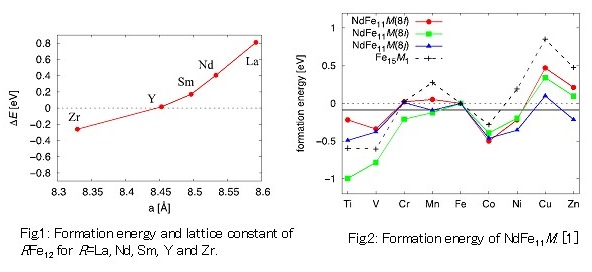1 AIST, Tsukuba 305-8568, Japan
2 NIMS, Tsukuba 305-0047, Japan
Abstract:
The ThMn12-type iron-based rare-earth compounds are potential strong permanent magnet compounds because of their high iron content. It has long been known that RFe12 is unstable and chemical substitution is necessary for thermodynamic stability. We discuss the structural stability and magnetism of the systems. A series of first-principles calculations of RFe12 for various R elements clarifies that, as the size of R becomes smaller, the Fe cage surrounding the R atom becomes smaller, and the system becomes more stable. Substitution of Fe sites with a third element affects both stability and magnetism. Introduction of interstitial nitrogen enhances the magnetization. The Curie temperature is also raised through the change in the Fe-Fe exchange couplings, whereas the couplings between the R and surrounding Fe sites are weakened as a consequence of p-d hybridization. A spin model analysis [2,3] suggests that the change in the R-Fe couplings has a big impact on the magnetocrystalline anisotropy at high temperatures. We will also present how machine-learning techniques can be utilized for materials exploration.

References
[1] Y. Harashima et al., J. Appl. Phys. 120, 203904 (2016).
[2] M. Matsumoto et al., J. Appl. Phys. 119, 213901 (2016).
[3] Y. Toga et al., Phys. Rev. B 94, 174433 (2016).
[1] Y. Harashima et al., J. Appl. Phys. 120, 203904 (2016).
[2] M. Matsumoto et al., J. Appl. Phys. 119, 213901 (2016).
[3] Y. Toga et al., Phys. Rev. B 94, 174433 (2016).



